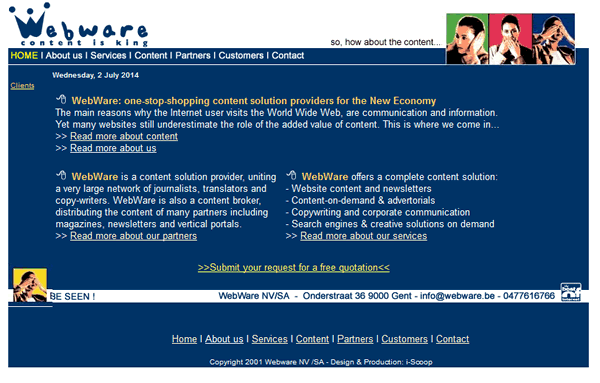 If you visit this website on a more or less regular basis, you might have noticed that we’re in the middle of a migration and integration process. We’re doing it in-between other work and manually, for very good reasons. And it’s a lot of work.
If you visit this website on a more or less regular basis, you might have noticed that we’re in the middle of a migration and integration process. We’re doing it in-between other work and manually, for very good reasons. And it’s a lot of work.
However, it was time to rationalize and stop having xyz platforms. And this site is where everything regarding content marketing and related topics, will – hopefully – end up in a few months from now. It’s not the first time we migrate platforms. Having been active in “digital”, media, marketing etc. for far too long, my first website migration – with a huge taxonomy exercise and as we called it back then a “Web 2.0” overhaul – concerned a parenting website we integrated with another one, which got bought by publishing company Sanoma, that wanted to give it more of a community dimension, back in those days when blogs just started popping up.
In other words: we’re talking a long time ago. We still had a website on content management, used several content management systems and even had “developed” a simple one ourselves (yes, once, my small company powering this site, i-SCOOP, also developed websites, don’t ask for examples please).
The history of content marketing
Now, with our WordPress installs it’s much easier of course but still: we do it gradually and manually. Why am I telling you all this? Well, one of the pages we recently migrated and updated took us back in time, when the term content marketing didn’t exist yet.
When updating a page with definitions on content marketing – I’ve been trying to keep up-to-date since quite some time as I think definitions and how they change over time matter – I started looking at Google Trends to see when the term content marketing first appeared online. To my surprise, I saw results, going back to 2004. But it quickly turned out all of them – when checking deeper – where antedated. What is certain, is that the term ‘content marketing’ was first used in a website content context at the end of the nineties and that the idea of thinking more like publishers goes back quite some too as well.
However, it’s clear that the real success came after Joe Pulizzi coined and evangelized content marketing more recently.

Of course, as Joe is the first to say, content marketing isn’t new. Until I find an old example on an attic of an old farm somewhere in, let’s say, Dunaszentmiklós, legend goes that among the first examples of content marketing are The Furrow, a customer magazine that is published by John Deere since 1895, and the Michelin Guide. Fun trivia – and good for a nice illustration – thanks to this post by Garrett Moon.
Over 13 years of online content that, well, could be more visitor-centric
What isn’t new either is the need for relevant and customer-oriented content, offline and online. Or let me put it otherwise: the value of good content for customers, visitors, users, brand, conversions, whatnot. I dedicated my career to it, from long before anyone had a commercial website or even used email (“say what, email?”) Visitor-centric content. Reader-centric. Or as we started calling it (well, Nielsen’s John Burbank did) “the audience-centric Web”.
When doing the “going back in time” exercise I stumbled upon a very old website (September, 2001) with a logo that said “content is king” (still made some sense in those days, given the context at the time) and the company behind it describes itself as “the one-stop-shopping content solution providers for the New Economy” (who can invent such a long and silly sentence?).
The company explains the reason of its’ existence on the website as follows: “The main reasons why the Internet user visits the World Wide Web, are communication and information. Yet many websites still underestimate the role of the added value of content.“. Offered services: website content, newsletters, content-on-demand, a pool of content creators, providing third-party content, creating advertorials, search engine services (obviously related with content) and more.
In the section on ‘content’ the website refers to a quote from someone at Gartner I had long forgotten: “Humans consume understandable content, not networks or databases”. Don’t you just love that?
Some more quotes from that section:
- “In an Internet context the word content stands for the texts, images, music files, games, financial charts and so on, within a certain website. As such content is the opposite of the technological aspect of a website. The content is the added value that goes into the technological frame”. OK, don’t entirely agree.
- “Without content there is no Internet, without content a web surfer will only visit your site once. Unfortunately the WWW still counts a large amount of expensive websites with great e-commerce possibilities but without any content at all”. Needs some editing I think.
- “According to Jupiters consumer survey content (information) and communication are by far the main reasons why people use Internet. Furthermore it is a fact that even the “off-line shoppers” use the Internet to find information about products ans services, before buying them”. Very true, even more true today: for all sorts of buyers.
- “Another proof of the massive impact of content lays within the fact that it is exactly the lack of local and niche content that will keep some people back of using Internet”. Don’t fully get that.
The website even had a section with content on…content and media, both syndicated and written by the “staff”. And it had a content marketplace. 2001!
Anyway, it’s clear there was a case for more relevant content on websites – and in newsletters, also part of the offering – in those days, as the “3 monkeys” animated GIF (well, it’s a stock image of someone with the famous 3 monkeys poses and some text) shows. Below is a screenshot of the website and the company who built it. I found it on the Internet Archive WayBackMachine, a site that takes snapshots of websites since ages and never enables antedating. As said it’s from September 2001. You can click it and see the silly animated GIF (oh, wait, animated GIFs are cool again now, I forgot!).

Yes, you felt this coming: I was the general manager of the – admittedly small and short-lived company that essentially did the same my company did. I invented the long sentence, came up with the business plan, made the silly animated GIF, was the “staff”, wrote the quotes and built the website (just static HTML) as the “design and production” message on the bottom says. The only thing I didn’t chose was the company’s name.
 However, if you ever received an invoice from my own company, i-SCOOP (Webware was part of a – pre-dotcom bubble – group, that went public just before the bubble burst), before the ongoing integration and rebranding exercise we’re going through, you might have seen the silly logo and slogan on the right-hand side: “from content to commerce”. Stupid, isn’t it? The idea there would be a relationship between content and revenues.
However, if you ever received an invoice from my own company, i-SCOOP (Webware was part of a – pre-dotcom bubble – group, that went public just before the bubble burst), before the ongoing integration and rebranding exercise we’re going through, you might have seen the silly logo and slogan on the right-hand side: “from content to commerce”. Stupid, isn’t it? The idea there would be a relationship between content and revenues.
It’s still about experiences
So far for this little ego-trip and at the same time trip down memory lane. But, rest assured: I know my place, am not king personal branding and wasn’t he only ones pushing businesses to improve the content on their websites. That’s why much later, when organizing my first own events (as in with my own company, not as a publisher), I had speakers coming over such as Gerry McGovern and Bryan Eisenberg (they wrote books on all those topics and back then in this tiny country Belgium where all this happened, there wasn’t too much to read in our local languages about digital marketing, except on the website I launched back then too – another story – and folks like Gerry and Bryan just knew and showed the way).
The real reason I share these screenshots and this little story – maybe on top of some weird ego-trip indeed – is 1) because still today many corporate websites have content that sucks, 2) I used to be a very bad designer and better stay away from it, 3) I’m getting old and 4) that mobile phone number on the website still works. Don’t call it as we don’t do websites anymore but do call someone to make your content unsuck as the challenges are still the – darn – same ones: customer-centricity and the user experience of the digital consumer. A digital consumer (what a weird term, let’s say people increasingly using digital stuff), that has – well, changed a bit to go for the understatement of the year – since 2001, as opposed to some organizations.
Take this one (1) content step today
Again, this was more self-promotional or ego-tripping than usually perhaps (at least, according to my Belgian ‘cultural code’) but what the heck, maybe soon I’ll post a content marketing case from the own archives from 1992 or before. Until it’s clear what content marketing should be about, with apologies for the arrogance (it’s more a feeling of “how long can one repeat the same messages and isn’t it about time to go and herd sheep”, 13 years repeating the same stuff is a long time as more of us know and those 13 years are just in English, imagine how long it is in my native language).
So, here is what I hope you do today if you happen to have had the courage to read all this.
I hope this little blog post will help you – or someone somewhere – fight for a budget to optimize the online content offered via your website (or any other channel), simply by creating a little plan and content to answer the questions visitors are looking for in the most efficient, relevant and task-oriented (or customer-centric) way like one of the “modern-day” content marketing and “inbound marketing” role models, Marcus Sheridan, did with his swimming pool and spa company.

Because, regardless of all the research on customer-centricity, the need to integrate around the customers, the need to optimize content – and much more – there still is a lot of work to do. Most money still goes to reach, traffic and the top of the proverbial funnel while optimization – and thus by definition the customer/user/visitor – is totally underestimated in the “mix”.
And, if you talk about it for approximately a decade and a half (or more), you’re either crazy, utterly wrong, stupid, stubborn, bitten by a “Messiah” syndrome, on a weird mission or just really hoping marketing gets more relevant based on what you have learned (or all of those and more).
Get that budget, start looking at what’s missing to give visitors what they seek and just do it.
More content marketing lessons for the present from the – digital – past.

